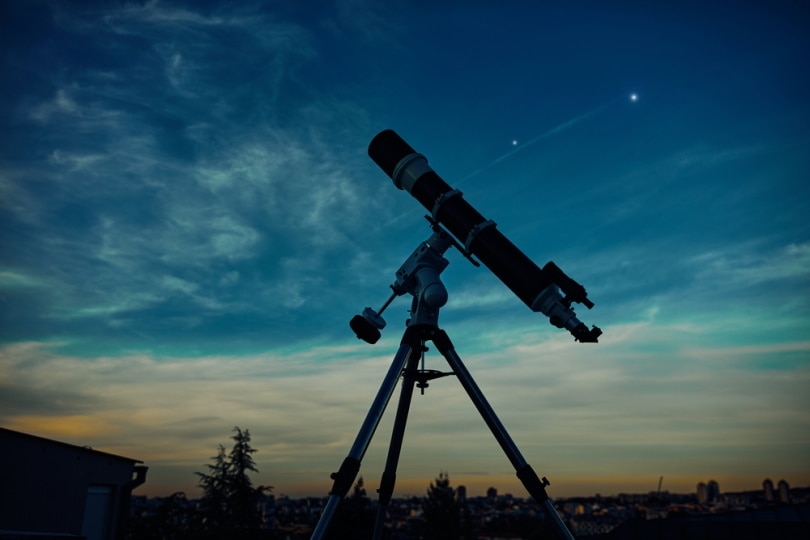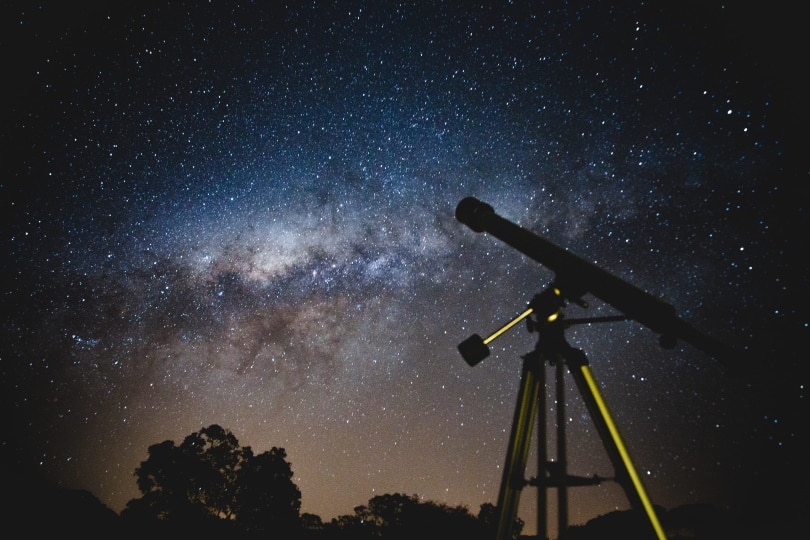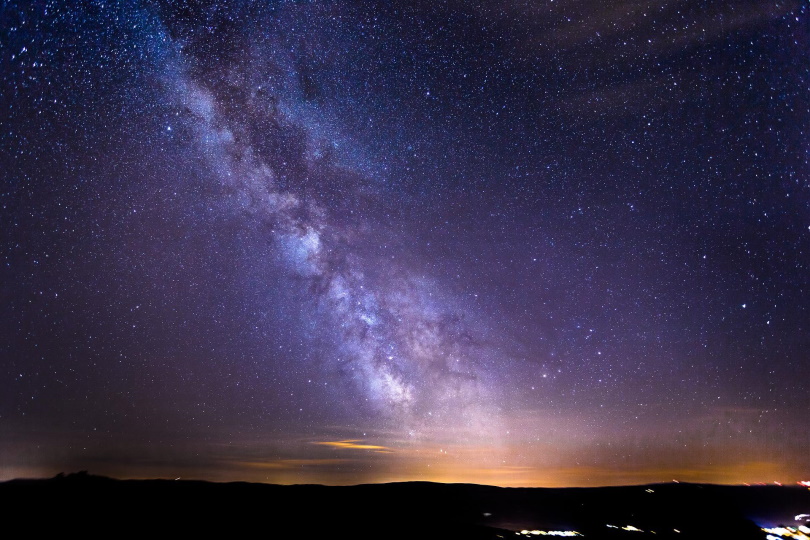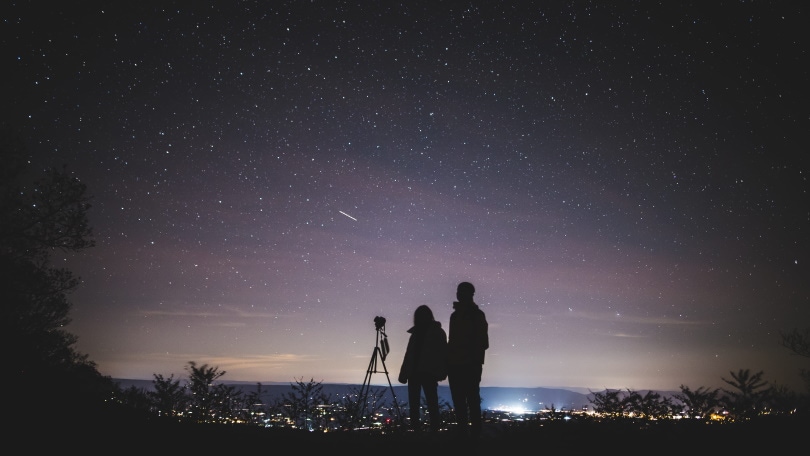12 Interesting Facts About the Sky You Never Knew (2024 Updates)
Last Updated on

When you look up at the sky, you’re looking at far more than you might realize. That’s why we highlighted 12 different facts about the sky. Even if you’ve heard a few of them before, these are still mind-blowing information that can permanently reshape how you think about the sky!

Top 12 Facts About the Sky
1. The Moon Has a Lemon Shape
When we look up at the moon at night, it looks like a perfect circle, and from our vantage point on Earth, it is. It wasn’t until we left Earth and explored the Moon in space that we saw that it really has a lemon shape.
We think that the Moon got its shape shortly after its formation from the gravitational pull of the Earth. In short, Earth’s gravity stretched the moon out, but since it was pulled directly toward Earth, it still appears like a perfect circle to us!
2. Some Visible Stars Are 19 Quadrillion Miles Away
The star Deneb sits somewhere between 2,600 and 3,000 light-years away, translating to around 19 quadrillion miles. With a magnitude of 1.25, Deneb is often one of the brightest stars in the sky.
While that’s quite a distance, it’s still extremely close by astronomical standards. The Milky Way is 52,850 light-years across, so 19-quadrillion miles is still in our backyard!

3. There Are Around 2 Trillion Galaxies in the Universe
The universe is big — really big. In fact, a new study indicates that there are around 2 trillion galaxies in the observable universe.
However, many scientists think that many of these galaxies have merged into other galaxies over time, so the current number is likely smaller, though the galaxies themselves are larger.
But while there are many galaxies in the universe, you can’t see hardly any of them from your backyard.
4. There Are 100 Billion Stars in the Milky Way
There are tons of galaxies in the observable universe, and if the Milky Way is any example, that means there are tons of stars. The European Space Agency estimates that there are around 100 billion stars in the Milky Way alone!
That number is constantly in flux, though. As old stars die, new ones are born, so the exact number of stars is constantly changing. Since nobody counts them all out individually, it’s more of an estimate.

5. There Are 200 Billion Trillion Stars in the Universe
There are many stars in each galaxy and many galaxies, and when you combine the two facts, you get staggering numbers when calculating the total number of stars in the universe.
According to Brian Jackson, an associate professor of physics at Boise State University, there are roughly 200 billion trillion stars, a.k.a. 200 sextillion, or 200 with 21 zeros after it. It’s just an estimate, but there are still more stars out there than you can wrap your head around.
6. When You Look at Stars, You’re Looking at the Past
Everything takes time to travel and light is no different. It takes about 8 minutes and 20 seconds for light from the sun to reach us, and it’s right by our planet. The farther out in space something is, the longer it takes its light to travel.
Light from Sirius takes 8.6 years to reach us, and if you spot the Andromeda galaxy, it took 2.5 million years for that light to reach us. That means when you’re looking at that galaxy, you’re looking at how it appeared 2.5 million years ago.
If there is life on a planet in that distant galaxy, if they’re looking at the Milky Way, they’ll see how things looked 2.5 million years ago, long before Homo sapiens even began to develop!

7. Clouds Are Heavy
When you look up at the sky, you often see large fluffy clouds, and because they’re floating around, they look lightweight. That couldn’t be further from the truth.
According to the United States Geological Survey, the average cumulus cloud weighs 1.1 million pounds! Clouds might not be dense, but they hold up a ton of weight.
8. Stars Don’t Twinkle
If you look up at the night sky, you might see a star blinking in and out of existence. We call this a twinkle, and it’s a common occurrence when you’re looking at stars. But despite what you’re seeing, stars don’t actually twinkle.
It has to do with the visible light passing through Earth’s atmosphere and the effect that this has on what you can see. If you ever get to head out to space and look at the stars, you won’t see any twinkling!

9. Some Planets in Our Solar System Appear Brighter Than Stars
Stars are far brighter than planets, but when you look up at the night sky, it does not always appear that way. It all has to do with the distance between us and the planets compared to the distance between us and the stars.
Besides Jupiter and Saturn, planets in our solar system don’t produce their own light, but rather reflect light from the Sun. However, even with reflected light, the planets Mercury, Venus, and Mars still outshine most stars.
With the light that they generate and reflect, Saturn and Jupiter outshine stars too. They might not actually be brighter, but they look that way to us because they’re closer!
10. You Can Only See Half the Night Sky at Once
When you look up at the night sky, you see tons of stars, but what’s staggering is that you can only see about half of the night sky at one time.
There’s a great deal of math that goes into proving this, but if you consider that you’re standing on a sphere, it all makes sense. You can’t see through the Earth to see what’s on the other side, and even when we are facing that way, the Sun is so bright that it blocks out everything else that we could see.

11. You Can’t Take a Picture of the Entire Milky Way
Any pictures of the Milky Way are artists’ renderings. In order to get a picture of the entire galaxy, we’d have to leave the Milky Way.
No one has ever done that, so there are no photos of the entire Milky Way. Everything that we’ve seen only shows a portion at a time, and it all comes from the same perspective. This also makes it challenging to see what’s going on at the other side of the galaxy, especially considering the Earth sits near the outside.
12. You Can Only See Several Thousand Stars at Night
Even if you get some of the best viewing conditions to see the night sky, you’re not seeing millions of stars. In fact, the most that you’re going to see with just your eyes is around 6,000.
That’s still plenty of stars but considering that there are 100 billion stars in the Milky Way and 200 billion trillion in the universe, your eyes can’t even scratch the surface of what’s out there.


Conclusion
The sky is an interesting place, and we often completely overlook it as we go through the hustle and bustle of our day. Hopefully, with the newfound information from this list, you can go about your day and night thinking more about everything that’s up there!
Featured Image Credit: AstroStar, Shutterstock
Table of Contents
- Top 12 Facts About the Sky
- 1. The Moon Has a Lemon Shape
- 2. Some Visible Stars Are 19 Quadrillion Miles Away
- 3. There Are Around 2 Trillion Galaxies in the Universe
- 4. There Are 100 Billion Stars in the Milky Way
- 5. There Are 200 Billion Trillion Stars in the Universe
- 6. When You Look at Stars, You’re Looking at the Past
- 7. Clouds Are Heavy
- 8. Stars Don’t Twinkle
- 9. Some Planets in Our Solar System Appear Brighter Than Stars
- 10. You Can Only See Half the Night Sky at Once
- 11. You Can’t Take a Picture of the Entire Milky Way
- 12. You Can Only See Several Thousand Stars at Night
- Conclusion
About the Author Robert Sparks
Robert’s obsession with all things optical started early in life, when his optician father would bring home prototypes for Robert to play with. Nowadays, Robert is dedicated to helping others find the right optics for their needs. His hobbies include astronomy, astrophysics, and model building. Originally from Newark, NJ, he resides in Santa Fe, New Mexico, where the nighttime skies are filled with glittering stars.
Related Articles:
15 Crucial Facts About Ultraviolet Rays & the Sun
What Constellation Is Spica In? The Interesting Answer!
10 Interesting Leo Constellation Facts, Myths, and FAQs
15 Interesting Pegasus Constellation Facts, Myths, and FAQs
6 Interesting Sagittarius Constellation Facts, Myths, and FAQs in 2024!
What Are Constellations? Where Did They Come From?
8 Interesting Libra Constellation Facts, Myths, and FAQs
What Is Infrared Radiation? Science-Based Facts & FAQ
